Emerging Auto-Competitive Transit Technologies: A Brief Review
At this time (late 2002), a lively debate is underway that is focused on the
reauthorization of the federal transportation program for the next 6 years. The major
stakeholders have identified their funding needs for building and maintaining highways and
transit systems during this period and they are staggering. For example, the American
Association of State Highway and Transportation Officials has produced a report entitled
"The Bottom Line" recently. It concludes that an average of $92 billion per year
will be needed to maintain the current physical condition and performance of the highway
system over the next 20 years and that $126 billion per year will be to improve the
system. Further, they estimate that $19 billion is needed annually to maintain the
nation’s transit systems, while another $44 billion is the annual estimated need for
transit system improvements. The total annual estimated bill - $281 billion!
Certainly, patching-up and extending the highway system is urgent and necessary. But we
need to find a much more cost-effective way that some of these transit funds could
be invested that would provide for greatly increased levels of non-auto mobility. Today's
transit investments in new starts do not exhibit anything close to a reasonable
cost-benefit ratio. Despite their enormous cost and construction disruption, they are not
having any appreciable effect on congestion and air quality problems and exhibit a
declining patronage market-share.
As a result, many people are looking for transit technologies that would produce greatly superior results. They are offering a vision of future urban transportation that looks to be much more cost-effective than a continuation of more investments in conventional rail and bus technologies.. They hope to provide some relief from the high cost, ruinous congestion, negative environmental impacts, risky oil dependency and global warming threats that we currently face.
In the 1960’s and 1970’s our federal government sponsored studies with titles like "Toward a National Urban Growth Policy" that looked at future population projections and attempted to identify ways to accommodate growth that would both maintain and enhance the livability of our cities. Today, we have no such study to provide a framework for discussing this complex issue. But, according to the U.S. Census Bureau, the U.S. Population Forecast (Middle Series) describes a likely increase from 279 million in 2002 to 394 million in 2050, an increase of some 115 million. One thing that we know for sure is that the provision of new transportation infrastructure strongly influences when and where urban growth will occur. Lacking any kind of national urban growth strategy, such decisions will be made incrementally, mostly at the local level of government.
Conventional wisdom today says that our cities will continue to spread out and become less dense and that more and more highways will be needed to serve an even more dispersed city. This view of the future is nothing new. It was also recognized in a report to Congress entitled Tomorrow’s Transportation that was published in 1968 by the Johnson administration. This report recognized the likelihood that auto-dominance would continue but it also identified several non-auto urban transportation needs and technologies and urged that they be developed and made operational for use about now. An excerpt from that report is available on-line. Evidence of its long term validity stems from the fact that most of its recommended technologies are currently being worked on around the world. The purpose of this article is to present a brief review of just a few of the more than 70 new non-auto concepts that are under development and are being monitored at the Innovative Transportation Technologies website.
Auto-competitive transit – is it a fantasy?
For a non-auto transportation technology to be successful in the modern American city, it must be auto-competitive. This means that is must be widely available, be almost as fast as the auto and provide a superior level of service, in at least some respects, in comparison to personal auto use on the increasingly congested highway system. It must be so good that it will be chosen by large numbers of people for a wide variety of daily trips, the vast majority of which are not the home-to-work commute trips that transportation planners and the general public tend to focus on. Does such an auto-competitive transit system exist today? Yes, but only for the relatively small number of work trips to downtown in a city with substantial mass transit facilities. Could a more useful system, designed to serve the vast majority of non-downtown daily trips in a metropolitan area be developed? Could it be deployed at a reasonable cost in a reasonable period of time with minimal construction disruption and little, if any, negative impacts on the environment? Surprising as it seem the answer is – yes.
Skeptics point to data that show that fewer than 5% of all person trips each day in a large U.S. metropolitan area use transit now. This figure is very misleading because it does not recognize that auto-competitive transit, in the few cities where it exists, often has a market share in the 30-40% range for peak period trips to and from a significant downtown that is well-served by some form of mass transit. These are mostly work trips and they occur during the most congested parts of the day. But, they are not a very significant part (usually less than 20%) of the huge number of trips made throughout the entire day in a metropolitan area. This is why the daily market share figure for transit is so low.
Is it really impossible to provide auto-competitive transit service to the vast majority of daily trips that are not downtown-oriented trips and that contribute so much to the ever growing levels of congestion in our metropolitan areas? Is downtown the only location in a metropolitan area where auto-competitive transit service is possible? Certainly it is -- if one is limited to considering only conventional rail and bus technologies. They are far too costly and too slow to serve a very dispersed trip pattern in competition with the private auto. If one is willing to challenge this constraint, then many other emerging and appropriate technologies can be considered and evaluated.
Wendell Cox has suggested a two-part definition of "auto-competitive transit" that is a good starting point for a discussion of this concept. It is as follows:
100 Percent Trip Specification: All people in the metropolitan area should be able to reach any other location in the service area within a time that is no more than 50 percent greater than that of an automobile trip.
80 Percent Residence-Work Trip Specification: 80 percent of the residents can reach 80 percent of the jobs in an urban area by auto-competitive transit. This would provide for 64 percent connectivity between jobs and residences in the urban area (0.8 x 0.8 = 0.64)
The first specification above deals with the provision of competitive travel times while the second requires that such a trip be physically possible, given a particular route and station layout of the transit system. Clearly, the first specification is very difficult to satisfy, but some radial rail services in some metropolitan areas probably come reasonably close to doing so today. But because trips to downtown are a very small proportion of the total daily trips in a metropolitan area, the first specification is not even close to being met for the total population in any of our metropolitan areas today.
The second specification is even less likely to be satisfied in our very dispersed metropolitan areas, especially in the western part of the U.S. In most cases, more than 80% of all jobs are not located in a downtown but are scattered throughout the metropolitan area in a polycentric but very dispersed fashion. Currently, transit market shares to non-downtown activity centers in our metropolitan areas rarely reach 10% and are usually much less than that. Satisfying this second specification is a truly daunting task.
Further, it is not difficult to think of additional specifications that could and should be added to this simple definition of auto-competitive transit. Trip attributes such as comfort, reliability, safety, stress-level, wait times, walk times, parking costs and difficulties, non-stop travel and out-of-pocket cost come immediately to mind. But, before making the task more complex and difficult, let us first ask two questions: What kind of transit system would it take to satisfy just these two specifications? Secondly: What are the prospects for actually being able to build such a system in the near future?
Three Promising Pathways to the Future
Group rapid transit(GRT)is a term that refers to a system very much like PRT, except that the vehicles are larger as are the guideways and stations. Some have off-line stations which makes non-stop service possible but some do not, requiring a stop at each station. GRT systems are likely to be more expensive than PRT systems because of larger vehicles, guideways and stations but may provide more capacity, in some applications. A GRT system has been successfully operated at West Virginia University in Morgantown for more than 25 years.
Dualmode transportation is a term that describes a transportation system whose vehicles can be operated on both the conventional street system and on an exclusive, automated guideway under computer control. Clearly, such a system can provide door-to-door service which neither PRT nor GRT systems can do. Otherwise, the DM is similar to the other two concepts in most respects. But, far fewer miles of elevated guideway are needed for a dualmode system and a much smaller number of stations would be required as well. Travel on the automated part of the system would be hands-off, view-rich and probably somewhat faster that a comparable PRT or GRT system.
Let’s be very clear about one point. None of these systems, if implemented, could be expected to replace the auto and leave the conventional roadway system empty and unused. But, depending on how intelligently they are implemented, they offer a significant potential for reducing auto dependence for travelers within our cities. Moreover, none would require the huge costs that have been experienced in tearing up and tunneling under our cities to build conventional rail and bus systems. In fact, dualmode systems offer the possibility of significantly lower costs as privately-owned dualmode autos would be common instead of all PRT and GRT vehicles having to be purchased and operated by some public or private agency.
Three Examples of Emerging PRT Systems
Only very brief descriptions will be provided here. More details and numerous illustrations are available at the websites for each technology, listed at the end of this article.
There are three PRT systems currently under development at the present time. One is called Skyweb Express and it is located in the Minneapolis, Minnesota suburbs. A second is called ULTra and it is being developed in the U.K. A third is called MicroRail and it is being developed by a group located near Ft. Worth, Texas
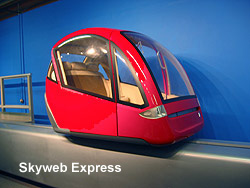 The Skyweb
Express concept is very well-developed and a Phase I prototype was completed in April,
2003. Funding for a Phase II development and testing program is now being
sought. If all goes well, it may be the first PRT ready for deployment in the U.S.
Skyweb Express is the invention of Professor J. Edward Anderson. His extensive studies of
various previous efforts to develop a viable PRT system in the U.K., France, Germany,
Korea, Japan and the U.S. have led him to his present, superior design. It overcomes the
problems uncovered by these previous development efforts and is now a world technological
leader.
The Skyweb
Express concept is very well-developed and a Phase I prototype was completed in April,
2003. Funding for a Phase II development and testing program is now being
sought. If all goes well, it may be the first PRT ready for deployment in the U.S.
Skyweb Express is the invention of Professor J. Edward Anderson. His extensive studies of
various previous efforts to develop a viable PRT system in the U.K., France, Germany,
Korea, Japan and the U.S. have led him to his present, superior design. It overcomes the
problems uncovered by these previous development efforts and is now a world technological
leader.
 The ULTra concept was developed initially at the University of Bristol in the
U.K and is now being actively pursued by a spin-off company with funding from the British
government and the EU. It is similar in its service attributes to Skyweb Express but
features a larger vehicle and a different type of guideway. A demonstration system is
currently planned in Cardiff, Wales. Initially, the ULTra vehicles will be captive to the
guideway but may eventually evolve into dualmode vehicles.
The ULTra concept was developed initially at the University of Bristol in the
U.K and is now being actively pursued by a spin-off company with funding from the British
government and the EU. It is similar in its service attributes to Skyweb Express but
features a larger vehicle and a different type of guideway. A demonstration system is
currently planned in Cardiff, Wales. Initially, the ULTra vehicles will be captive to the
guideway but may eventually evolve into dualmode vehicles.
 MicroRail is quite similar to Skyweb Express and ULTra in its
functionality but different in the way it has been implemented. It is one of a family of
systems being developed by MegaRail Transportation Systems in Texas. A MicroRail prototype
vehicle and guideway segment have been built and funding is now being sought to undertake
the construction of a full-scale test track and three operating vehicles. MicroRail is
aiming for a very low cost system that could be easily deployed in both industrialized and
developing countries around the world. A smaller version of MicroRail, called NanoRail,
and a freight system, called CargoRail, is also being developed.
MicroRail is quite similar to Skyweb Express and ULTra in its
functionality but different in the way it has been implemented. It is one of a family of
systems being developed by MegaRail Transportation Systems in Texas. A MicroRail prototype
vehicle and guideway segment have been built and funding is now being sought to undertake
the construction of a full-scale test track and three operating vehicles. MicroRail is
aiming for a very low cost system that could be easily deployed in both industrialized and
developing countries around the world. A smaller version of MicroRail, called NanoRail,
and a freight system, called CargoRail, is also being developed.
Two Examples of Emerging Group Rapid Transit Systems
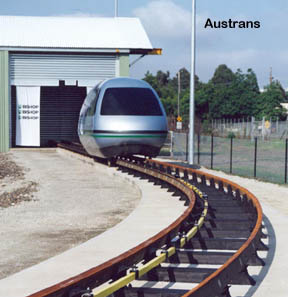 Larger vehicles are being developed by two other active companies.
Austrans is a GRT technology now being developed vigorously in Australia. Its vehicles
provide 8 seats and use steel wheels on steel rails. It is particularly well-suited to
travel within urban areas and can be built without the massive disruption and high cost
that is typically required by the construction difficulties and adverse impacts of trying
to fit conventional rail transit technologies into existing urban areas. A prototype
vehicle and test track has been constructed and a test site established where it is
currently undergoing a rigorous testing program.
Larger vehicles are being developed by two other active companies.
Austrans is a GRT technology now being developed vigorously in Australia. Its vehicles
provide 8 seats and use steel wheels on steel rails. It is particularly well-suited to
travel within urban areas and can be built without the massive disruption and high cost
that is typically required by the construction difficulties and adverse impacts of trying
to fit conventional rail transit technologies into existing urban areas. A prototype
vehicle and test track has been constructed and a test site established where it is
currently undergoing a rigorous testing program.
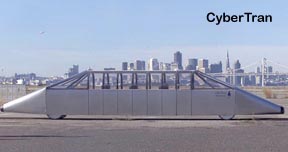 Another GRT system is called CyberTran. It is a passenger and light
cargo transportation system that would use large numbers of small (6-20 passengers), light
weight (10,000 lb. loaded), electrically powered, computer controlled (no driver) vehicles
operating on rails mounted on an elevated or ground-level exclusive guideway. It would
provide speeds that range from tourist (20-40 mph), to urban (40-75 mph), to high speed
(75-150 mph).
Another GRT system is called CyberTran. It is a passenger and light
cargo transportation system that would use large numbers of small (6-20 passengers), light
weight (10,000 lb. loaded), electrically powered, computer controlled (no driver) vehicles
operating on rails mounted on an elevated or ground-level exclusive guideway. It would
provide speeds that range from tourist (20-40 mph), to urban (40-75 mph), to high speed
(75-150 mph).
Two Examples of Emerging Dualmode Transportation Systems
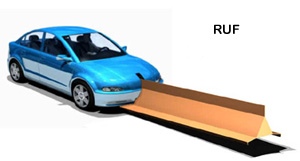 The two leading concepts in this field may be found in Denmark and Texas. The
Danish system is called RUF (Rapid, Urban, Flexible) and it represents a blend of rail and
roadway attributes. It features small, electric vehicles and a larger 10-passenger
electric vehicle for group travel. Both can be operated on the conventional roadway system
and can also travel on a special RUF monorail under full computer control. The monorail
will normally be elevated but can also be placed on the ground, when/where appropriate.
Door-to-door travel is featured and it is essentially environmentally benign. A prototype
monorail and private vehicle has been developed and initial testing is underway. RUF has
attracted attention and financial support from the EU CyberCar consortium and in many
other cities around the world (e.g. people in Copenhagen, Los Angeles, Seattle and Mexico
City have shown significant interest).
The two leading concepts in this field may be found in Denmark and Texas. The
Danish system is called RUF (Rapid, Urban, Flexible) and it represents a blend of rail and
roadway attributes. It features small, electric vehicles and a larger 10-passenger
electric vehicle for group travel. Both can be operated on the conventional roadway system
and can also travel on a special RUF monorail under full computer control. The monorail
will normally be elevated but can also be placed on the ground, when/where appropriate.
Door-to-door travel is featured and it is essentially environmentally benign. A prototype
monorail and private vehicle has been developed and initial testing is underway. RUF has
attracted attention and financial support from the EU CyberCar consortium and in many
other cities around the world (e.g. people in Copenhagen, Los Angeles, Seattle and Mexico
City have shown significant interest).
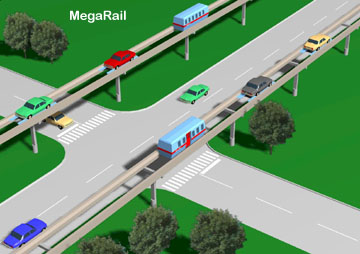 MegaRail (MicroRail’s big brother) is currently the leading
U.S. dualmode concept and it is being developed near Ft. Worth, Texas. It differs from RUF
in substantial ways but would provide most of the same kind of service attributes.
MegaRail can provide higher-speed, automated service for longer trips and intercity trips.
The MegaRail elevated guideways are larger than the RUF guideways but they are open in the
center and probably will not pose difficult visual intrusion problems in most urban
locations. Prototypes have been constructed and are available for inspection. MegaRail and
MicroRail vehicles and guideways are highly similar except for their size. The MegaRail
guideways have been designed to accommodate a dualmode electric car and pallets that can
be used to carry conventional autos. A CargoRail version is also planned that would use
the same guideway.
MegaRail (MicroRail’s big brother) is currently the leading
U.S. dualmode concept and it is being developed near Ft. Worth, Texas. It differs from RUF
in substantial ways but would provide most of the same kind of service attributes.
MegaRail can provide higher-speed, automated service for longer trips and intercity trips.
The MegaRail elevated guideways are larger than the RUF guideways but they are open in the
center and probably will not pose difficult visual intrusion problems in most urban
locations. Prototypes have been constructed and are available for inspection. MegaRail and
MicroRail vehicles and guideways are highly similar except for their size. The MegaRail
guideways have been designed to accommodate a dualmode electric car and pallets that can
be used to carry conventional autos. A CargoRail version is also planned that would use
the same guideway.
Implementation Problems and Opportunities
To repeat an important and often misunderstood point, none of these systems is likely to largely displace the greener and more efficient autos that will be produced by U.S. and foreign automakers in the future. However, if they can be sufficiently developed, survive a rigorous testing program and become market-ready at a highly competitive price (at least 3 times less than conventional transit technologies), they should find quite a large number of cities and private firms around the world to be ready and willing customers. Clearly, there are both technical and non-technical challenges yet to be overcome by all of the technologies included in this article.
Perhaps the greatest technical challenge that they all face is the development of a highly reliable software package that is needed to control a large number of vehicles that would be operated in a fully-automated mode. Such software packages have been developed and tested in limited ways but none have yet been subjected to tests that involve interacting with large numbers of the general public, some of whom behave in unexpected ways at times. Yet, large-scale PRT simulations have been conducted that offer evidence that such systems can be expected to perform effectively on large urban networks involving thousands of vehicles and hundreds of stations. Clearly, small networks should be constructed first and tested with riders from the general public to verify these promising computer-based simulation results. The Morgantown GRT system has been operated successfully for more than 25 years and simulation studies are being developed by CyberTran and Austrans. Dualmode transportation systems face similar problems and significant simulation work is underway at RUF in Denmark. Dualmode systems have not yet been tested as extensively as PRT and GRT systems using computer-based simulation models.
Another difficult problem which is somewhat technical in nature has to do with the common reaction that these systems are not "mass transit" systems and therefore many people don’t believe that they would have the capacity needed to carry large numbers of people from place to place. But, study after study has shown that these system do have the capacity needed to meet the requirements of the great majority of potential urban applications in the U.S. Still, most people simply don’t accept such results because they don’t understand the differences between the vast capacity of an areawide network of elevated guideways as compared with the capacity of a typical, sparse, mass transit system serving only a few radial, linear corridors with a line-haul service.
The capacity of a PRT system, for example, has to be measured by its ability to move a large number of people over a network between a large number of stations with the average waiting time at each station being no more than a minute or two. One has to rely on a computer-based simulation model to make such a calculation as one can’t do it in their heads (i.e. intuitively) or by resorting to "common sense" notions. A PRT simulation of this type was done for Gothenburg, Sweden, and it found that an areawide PRT network could provide superior service as compared to the existing rail and bus network.
An example of a non-technical problem that all elevated technologies have to face has to do with what some refer to as the "visual intrusion" problem. Many static illustrations and computer-generated animations of "what it would look like" in various urban locations have been created. Still, there is considerable uncertainty about how the public will react to the prospect of these structures being placed in their communities. Reactions are likely to be highly variable and often quite unique to a particular location and set of community traditions and values. Many believe that this will be only a short-term problem.
Interesting studies of various ways of mitigating the visual intrusion of elevated guideways have been conducted in Sweden and many other countries. Moreover, similar studies have been conducted for large scale highway projects that are available to provide useful approaches to assessing this critical public acceptance problem.
Other technical, non-technical and public policy problems can be examined by looking at the Frequently Asked Questions (FAQ) sections of the websites for each technology. Most of the FAQs are quite extensive, having been developed over several years of vigorous web-based and personal discussions among advocates and their protagonists.
What Needs to be Done Now?
How can interested professionals, politicians and citizens encourage the evolution of these and other transportation alternatives? Several activities can be suggested. One would be to request that the Congress direct the U.S. Department of Transportation to conduct continuing assessment studies of the most promising alternatives and provide help to potential clients who wish to evaluate them for possible use in their locations.
A more vigorous approach would be for federal, state and local governments to fund an incubator facility that could assist various inventors develop and test their technologies and bring them to a market-ready state. California already has such a facility (called CalStart) but it is currently focused only on the development of cleaner and more efficient autos.
Concurrently, studies need to be conducted to determine how various new technologies might "fit in" most effectively with the current highway and rail transit systems. Probable land use impacts would have to be carefully considered as a careless application of any new transportation technology could produce adverse results in relation to adopted land use goals. In fact, the proper use of appropriate non-auto technologies could greatly assist the achievement of land use goals and actually help preserve many of the environmental amenities that are so often highly valued by local residents.
It will take some determined effort by lots of people before these systems can be built and placed in service. But, at least there are some attractive possibilities on the horizon that one can use to stimulate innovative thinking about the urban and intercity transportation problems of the future. Global warming and oil dependence problems are growing in magnitude and these systems offer some help in dealing with them as well. And, America needs some new manufacturing industries that produce products to sell to the rest of the world so as to reduce its massive and growing trade deficit. There are many more reasons to encourage these systems to emerge. They represent reasonable and affordable responses to a fast growing need for a more useful future transportation infrastructure.
More details on the seven technologies included in this review are available at the following websites:
PRT Technologies:
Skyweb Express: www.skywebexpress.com
ULTra: www.atsltd.co.uk
MicroRail: www.megarail.com
GRT Technologies:
Austrans: www.austrans.com
CyberTran: www.cybertran.com
Dualmode Technologies:
RUF: www.ruf.dk
MegaRail: www.megarail.com
Descriptions of more than 70 other innovative transportation technologies from around the world can be found at:
http://faculty.washington.edu/jbs/itrans
Jerry Schneider is Professor Emeritus, Department of Civil Engineering, University of Washington, Seattle